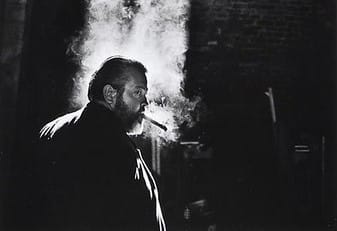The G.O.A.T — Greatest of all time — has become a common designation. Michael Jordan in basketball, Tom Brady in football, and of course, the person who coined the phrase, boxing legend Muhammed Ali. Sports fans love to debate the G.O.A.T., but you don’t see it often in other contexts. However, in the world of film, Citizen Kane has been considered the G.O.A.T. for decades. The 1941 classic was writer, director, and actor Orson Welles’ debut film. The movie launched Welles to stardom. Like most celebrities, Welles lived a luxurious lifestyle, including fine food, wine, and cigars. Here’s a look at the man many consider the greatest filmmaker of all time.
Orson Welles’ Early Career
Orson Welles was born in 1915 in Kenosha, Wisconsin, but moved to Chicago at a young age. The budding genius had lost both his parents by age 15. So he opted out of college, choosing to tour Europe instead. No one knows when Welles began smoking, but he started acting young. When he was in Ireland, he tried convincing the manager of the Gate Theater that he was a Broadway star. Although the manager likely didn’t believe the teenager, Welles began acting in minor roles at the Gate.
A few years later, Welles made another breakthrough, this time in radio. He performed anonymously as The Shadow, a popular radio show in the 1930s. However, his adaptation of H.G. Wells’ The War of the Worlds in 1938 made him world famous. The episode aired on Halloween and is as renowned for Welles’ distinct baritone narration as it is for causing widespread panic. The format, a regular news broadcast that depicted a Martian invasion, led some listeners to believe the Mars attack was an actual invasion. Photographs from that evening show the young Orson Welles clenching a cigar in his teeth and clutching the Mercury Theater microphone. Hollywood came calling shortly after.
Citizen Kane and Hollywood Outsider
Orson Welles co-wrote, directed, and starred in the biopic that still lands in the top spot on movie lists. Citizen Kane is loosely based on newspaperman and later politician William Randolph Hearst. Despite the film receiving critical praise, it was not a box office success, a pattern Welles experienced throughout his career. The film was nominated for several Academy Awards, including Best Picture and Best Director. However, it only won the Oscar for Best Original Screenwriting.
Like any cigar man, Welles was an original. Unfortunately, his pursuit of creative control over his projects often blackballed him from the Hollywood studio system. He worked in Europe throughout most of his career.
His innovative camera techniques and nonlinear narrative style made him one of the first film auteurs. Best known for his use of light, deep focus, and long takes, an even closer look shows how Welles loved to capture smoking in his movies.
Perhaps it is how smoke billowed and played off the light in black and white films, but Welles often wrote his favorite habit into his movies. Charles Foster Kane, played by Welles, smoked a pipe, but cigars took center stage in later films. In the noir classic, A Touch of Evil, Welles played the cigar-smoking detective Hank Quinlan. In his last film, the satirical film within a film, The Other Side of the Wind, John Huston constantly puffed on a Churchill. Huston played a movie director in the film. It was a likely stand-in for Welles, but Huston was also an avid cigar smoker.
Orson Welles’ Personal Life
Welles loved women, food, booze, and cigars. He married three times, including a nearly five-year marriage to legendary beauty Rita Hayworth. With fame came affairs with actresses and socialites. Welles was larger than life, but he was also a large man. He stood over six feet three inches and struggled with weight most of his life. The corpulent Welles played Shakespeare’s Falstaff in The Chimes at Midnight, one of three Shakespeare plays he adapted for the screen.
Welles’ opulent lifestyle likely attributed to his obesity late in life; this no doubt included premium hand-rolled cigars. However, no one knows the exact brand of cigar Welles preferred. Some claimed Montecristos. Either way, it’s challenging to find a photograph of the legendary Welles without a long cigar in his hand or between his lips, especially during his later years.
Photo credit: “Orson Welles en la grabación de Campanadas a medianoche (España, 1964)” by Recuerdos de Pandora is licensed under CC BY-SA 2.0.


